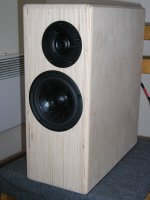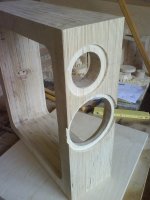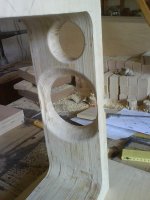I went back to my ZD5s determined to fix a bit loose bass.
A bit of history - my ZD5 is floorstander, but without sand chamber at the bottom. Baffle width is preserved, as well as internal volume by reducing depth significantly. I have no bracing, and there is removable back. Some extra height is added to allow for crossover placement at the bottom. Damping is polyester foam on top of 4mm bitumen. All done in 18mm MDF. I cannot keep them away from corners, so that does not help either.
First question - zaph strongly recommends scalloping bass driver holes, but at the same time, cabinet drawing indicates damping placement all the way to the front baffle and in between woofer and side walls, closing good portion of the scalloped openings, since the cabinet is very narrow. Should I remove some of the damping around the woofer to allow for better airflow?
A bit of history - my ZD5 is floorstander, but without sand chamber at the bottom. Baffle width is preserved, as well as internal volume by reducing depth significantly. I have no bracing, and there is removable back. Some extra height is added to allow for crossover placement at the bottom. Damping is polyester foam on top of 4mm bitumen. All done in 18mm MDF. I cannot keep them away from corners, so that does not help either.
First question - zaph strongly recommends scalloping bass driver holes, but at the same time, cabinet drawing indicates damping placement all the way to the front baffle and in between woofer and side walls, closing good portion of the scalloped openings, since the cabinet is very narrow. Should I remove some of the damping around the woofer to allow for better airflow?
Hi,
I decreased internal volume to about 15l(I put sand to bottom of the cabinet). It helped bit. You can even try about 10-11l internal volume as Troels have used in his Ellam design. You had removable back plate? Just glue correct sized piece of MDF to right place and fill rest of the cabinet with sand. This is what I would do...
Just try different amounts of damping material on different places.
Usually more damping material gives firmer bass.
Chamfering of the midbass driver hole helps to get better result in the midrange area.
I decreased internal volume to about 15l(I put sand to bottom of the cabinet). It helped bit. You can even try about 10-11l internal volume as Troels have used in his Ellam design. You had removable back plate? Just glue correct sized piece of MDF to right place and fill rest of the cabinet with sand. This is what I would do...
Just try different amounts of damping material on different places.
Usually more damping material gives firmer bass.
Chamfering of the midbass driver hole helps to get better result in the midrange area.
Last edited:
Hi,
Smaller volumes will make bass looser not tighter.
The best tuning expedient is lining the port with foam.
Same length as the port and ~ 3 times the diameter.
It will fit in and be self supporting.
This will drop the port frequency, tightening the bass,
at the same time increasing the lowest bass extension.
The thicker the foam, the more effect it has.
It works very well for matching speakers to rooms.
rgds, sreten.
Smaller volumes will make bass looser not tighter.
The best tuning expedient is lining the port with foam.
Same length as the port and ~ 3 times the diameter.
It will fit in and be self supporting.
This will drop the port frequency, tightening the bass,
at the same time increasing the lowest bass extension.
The thicker the foam, the more effect it has.
It works very well for matching speakers to rooms.
rgds, sreten.
Last edited:
Streten, Have you heard 15W/8530-K00 in 25 liter vented cabinet? Bass is loose. It goes deep, but I could hope more accuracy. In my view 15W/8530-K00 is meant for smaller cabinet and my listening experiments/trials are supporting that. Qts of this driver is pretty low.(0.27)
First I also added some foam to the vent as Streten proposed. It helped, but I felt that I lost some kick in the bass region. 15 liter cabinet and "free" vents gave better result in my room.
First I also added some foam to the vent as Streten proposed. It helped, but I felt that I lost some kick in the bass region. 15 liter cabinet and "free" vents gave better result in my room.
Last edited:
Streten, Have you heard 15W/8530-K00 in 25 liter vented cabinet? Bass is loose. It goes deep, but I could hope more accuracy. In my view 15W/8530-K00 is meant for smaller cabinet and my listening experiments/trials are supporting that. Qts of this driver is pretty low.(0.27)
First I also added some foam to the vent as Streten proposed. It helped, but I felt that I lost some kick in the bass region. 15 liter cabinet and "free" vents gave better result in my room.
Hi, No i've not heard the actual case you describe but I've detuned lots of speakers, rgds, sreten.
Your description and experience to me sounds self justifying, I've not found it to be the case.
Room matching is a critical aspect, and it may be case what you say worked for you.
But that is one room, and no reason to imply its generally true.
Last edited:
For few days I listened ZD5 without spikes or rubberfeet and then I installed rubberfeets. Sound improved bit, but bass was still loose. Cabitnets were made of birch plywood laminates. Wall thickness was roughly 2,5cm. I did not put bitumen on the walls, caused surface within the cabinet was not flat.
I closed the ports until I decreased the cabinet size.
Close the port fully and check how the sound changes. I am pretty sure that sound is clearer and you will hear more details. Bass will be tighter, but not deep.
Still I would say that 20 or 25 liters vented boxes are too big for 15W/8530-K00. If you for example have WinIsd simulation program, compare group delay between 25l closed and vented cabinet. You can also simulate 10 l or 15 l vented cab. 15W/8530-K00 is an excellent driver.
I closed the ports until I decreased the cabinet size.
Close the port fully and check how the sound changes. I am pretty sure that sound is clearer and you will hear more details. Bass will be tighter, but not deep.
Still I would say that 20 or 25 liters vented boxes are too big for 15W/8530-K00. If you for example have WinIsd simulation program, compare group delay between 25l closed and vented cabinet. You can also simulate 10 l or 15 l vented cab. 15W/8530-K00 is an excellent driver.
.....my ZD5 is floorstander, but without sand chamber at the bottom. Baffle width is preserved, as well as internal volume by reducing depth significantly.
zdr,
By changing the cabinet design as you noted above, I can't help but think you've unintentionally created a MLTL. Your "loose" bass may have more to do with internal standing waves than volume or porting. Zaph even had a blog entry some time ago regarding the hazards of long, small cross-section cabinets (I looked for it to provide a link, but couldn't find it).
Short of rebuilding the cabinets to Zaph's original specifications, you might try heavily damping and stuffing the bottom and top (leaving an open path to the port of course) to see if you can knock down any standing waves in the long direction. Perhaps Scottmoose or one of the other quarter wave gurus could model your cabinet quickly to give you an idea of what's going on.
Best of luck,
James
Here are a few pictures of the sealed ZD5 I have, 15L internal volume.
They are VERY sensitive to what they sit on, legs/no legs and I really think you should experiment with positioning and sand in the chambers.
Regarding the stuffing-no matter what you do you should always allow the Revelator to breathe, no kind of stuffing around it.
Tuning the port is a good and effortless experiment, specially if you use some foam or sock to stuff it - if you like it better that my give you an idea. I would also brace the box, the ZD5 is a very revealing speaker and you could easily hear the colorations from the box.
They are VERY sensitive to what they sit on, legs/no legs and I really think you should experiment with positioning and sand in the chambers.
Regarding the stuffing-no matter what you do you should always allow the Revelator to breathe, no kind of stuffing around it.
Tuning the port is a good and effortless experiment, specially if you use some foam or sock to stuff it - if you like it better that my give you an idea. I would also brace the box, the ZD5 is a very revealing speaker and you could easily hear the colorations from the box.
Attachments
Zaph on Tall Enclosures
Found it in his "Tidbits" section (scroll down about six sections): Link: Zaph on Tall Enclosures
Found it in his "Tidbits" section (scroll down about six sections): Link: Zaph on Tall Enclosures
I have reduced the volume to 16L and shortened the internal height of the box at the same time by putting internal plate at 65cm from the top, as Kamppi suggested. I also removed everything around the revelator, including bitumex, to allow for maximum airflow. According to WinISD simulation, tuning frequency raised from 30 to 37Hz as I did not touch the port. And yes, everything is improved. Bass tighter, mids cleaner and more detailed.
Since I am at it, I was wondering how to repair dust cap on revelator, that was pushed in by my daughter's finger. I took it out by puncturing a small hole in order to pull it, but it's still a bit crooked.
Since I am at it, I was wondering how to repair dust cap on revelator, that was pushed in by my daughter's finger. I took it out by puncturing a small hole in order to pull it, but it's still a bit crooked.
If you have an adjustable suck vacuume cleaner you can sometimes suck the center cap back out. However you need to be carefull you don't damage the cone especially if your cleaner has alot of power.
If you have poked a hole in the dust cap I suggest blocking it again with a drop of super glue as air will be wistling through it and will upset teh characterisitics of the drive unit. Use the smallest amount of glue you can as the added mass will also upset the drive unit slightly, but not as much as having a hole in it.
Regards,
Andrew
If you have poked a hole in the dust cap I suggest blocking it again with a drop of super glue as air will be wistling through it and will upset teh characterisitics of the drive unit. Use the smallest amount of glue you can as the added mass will also upset the drive unit slightly, but not as much as having a hole in it.
Regards,
Andrew
WOW, what a difference! I mean, even I can hear it! It's way better than removing earwax I don't know which of these mods literally turned the music on, but here's the list:
I don't know which of these mods literally turned the music on, but here's the list:
1) Scaloped driver openings (forgot to do it while it was easy)
2) Removed bitumex and damping around revelator
3) Reduced height of the box and thus the volume to 16L. Resulting bottom chamber filled with foam.
4) Attached soundcare spikes to bottom.
5) Bypassed tweeter's Audyn Cap Plus 4.3uF with 100nF Vishay MKP.
Can't wait to get back home
1) Scaloped driver openings (forgot to do it while it was easy)
2) Removed bitumex and damping around revelator
3) Reduced height of the box and thus the volume to 16L. Resulting bottom chamber filled with foam.
4) Attached soundcare spikes to bottom.
5) Bypassed tweeter's Audyn Cap Plus 4.3uF with 100nF Vishay MKP.
Can't wait to get back home
- Status
- This old topic is closed. If you want to reopen this topic, contact a moderator using the "Report Post" button.
- Home
- Loudspeakers
- Multi-Way
- ZD5 Reloaded.


